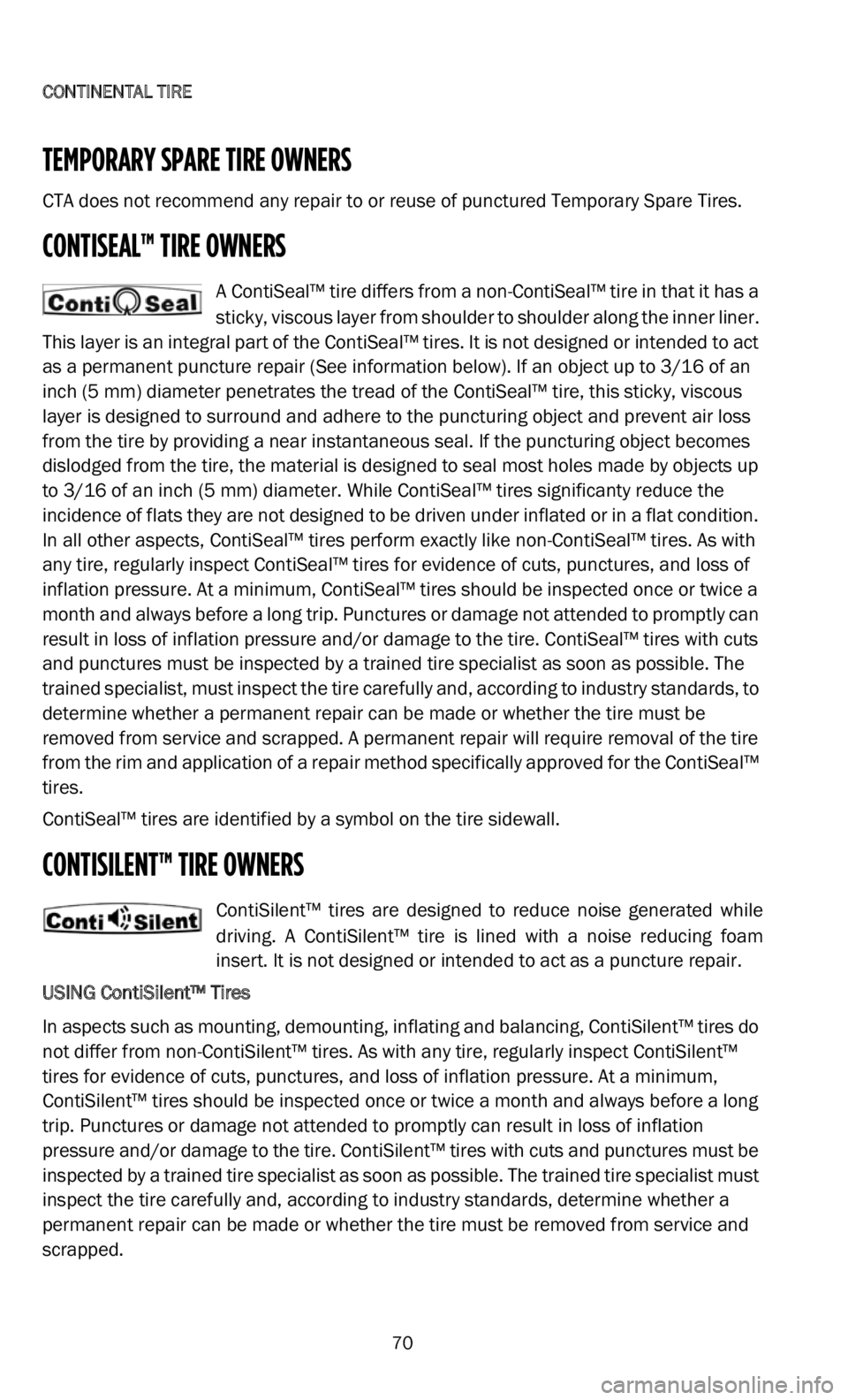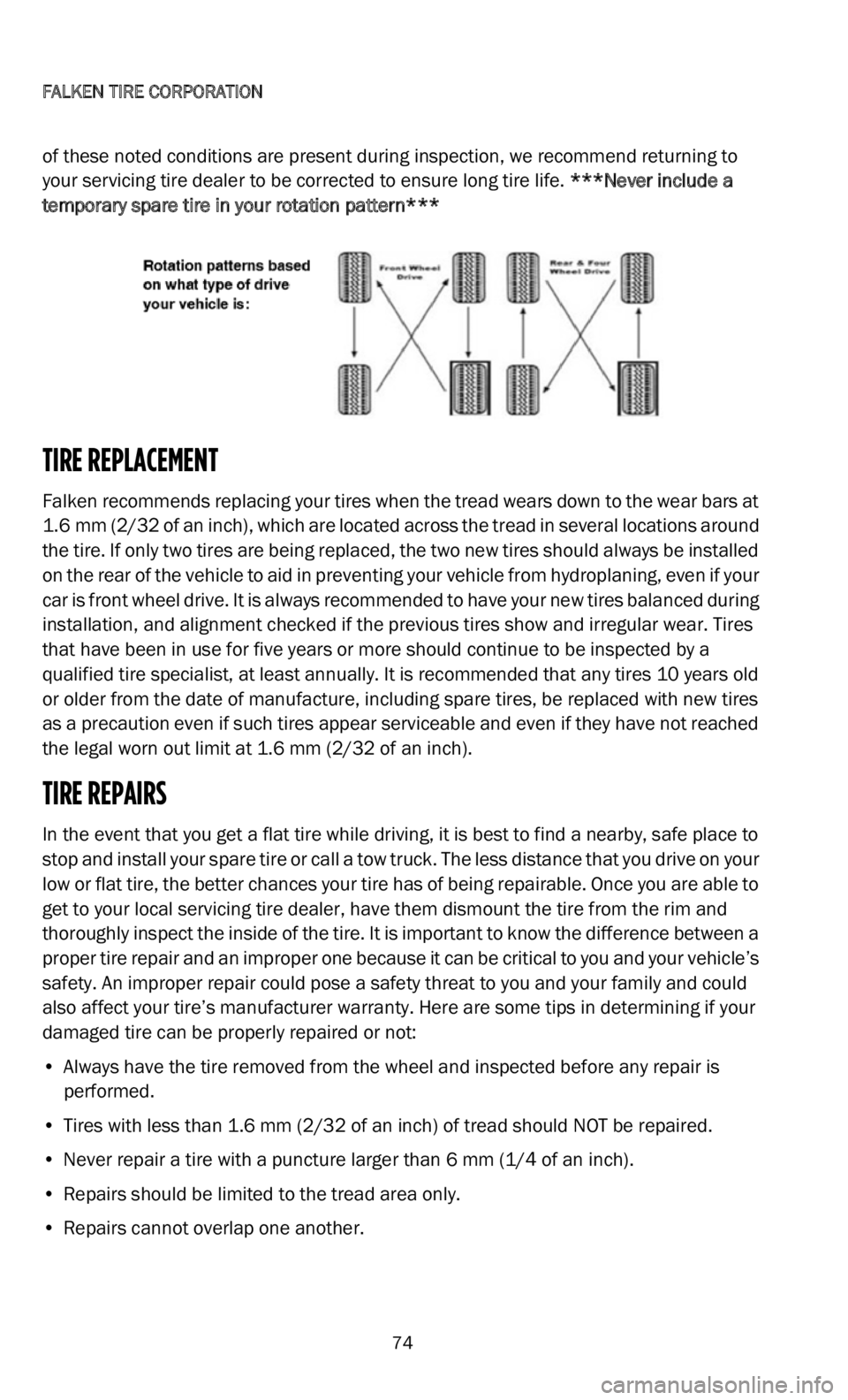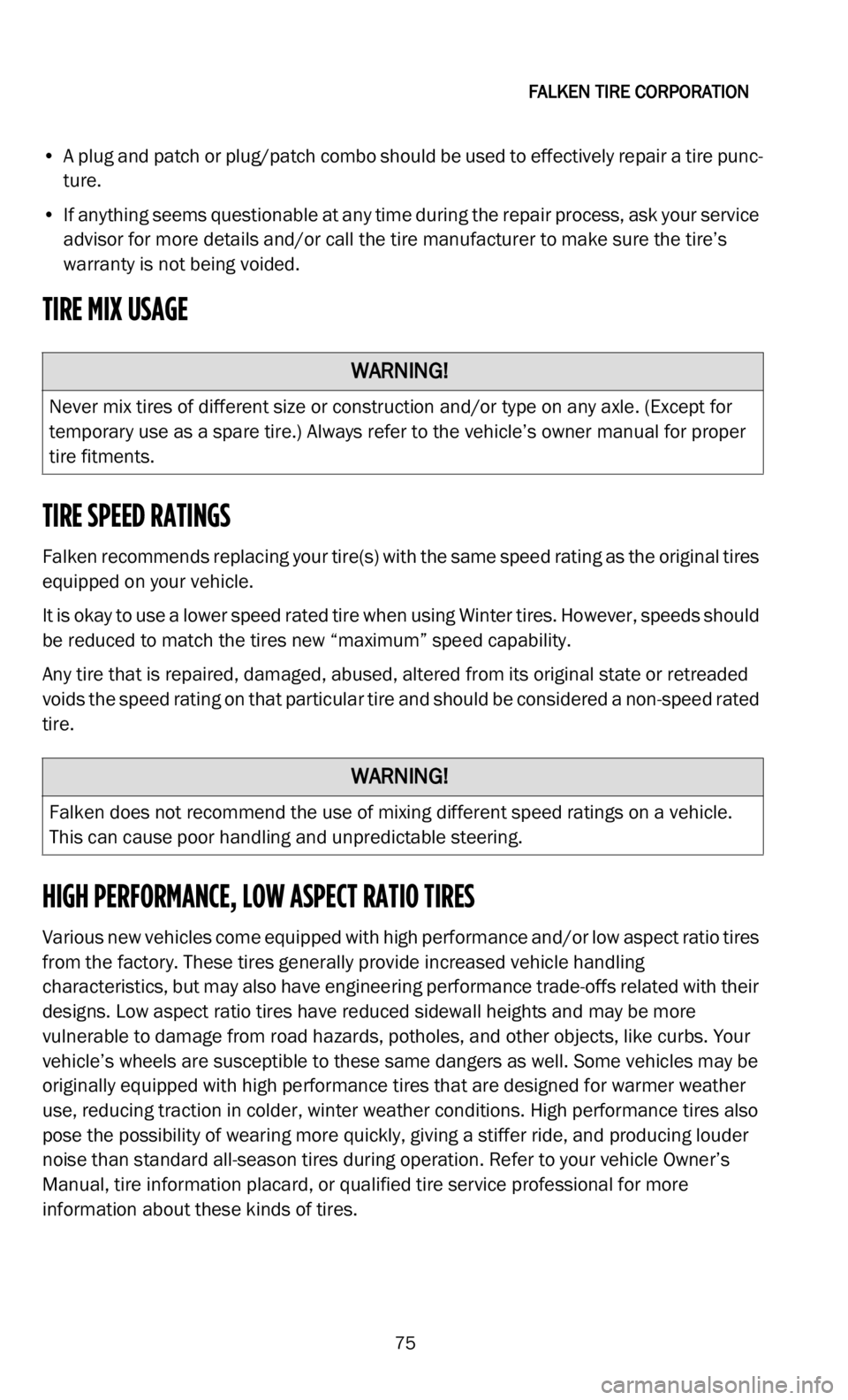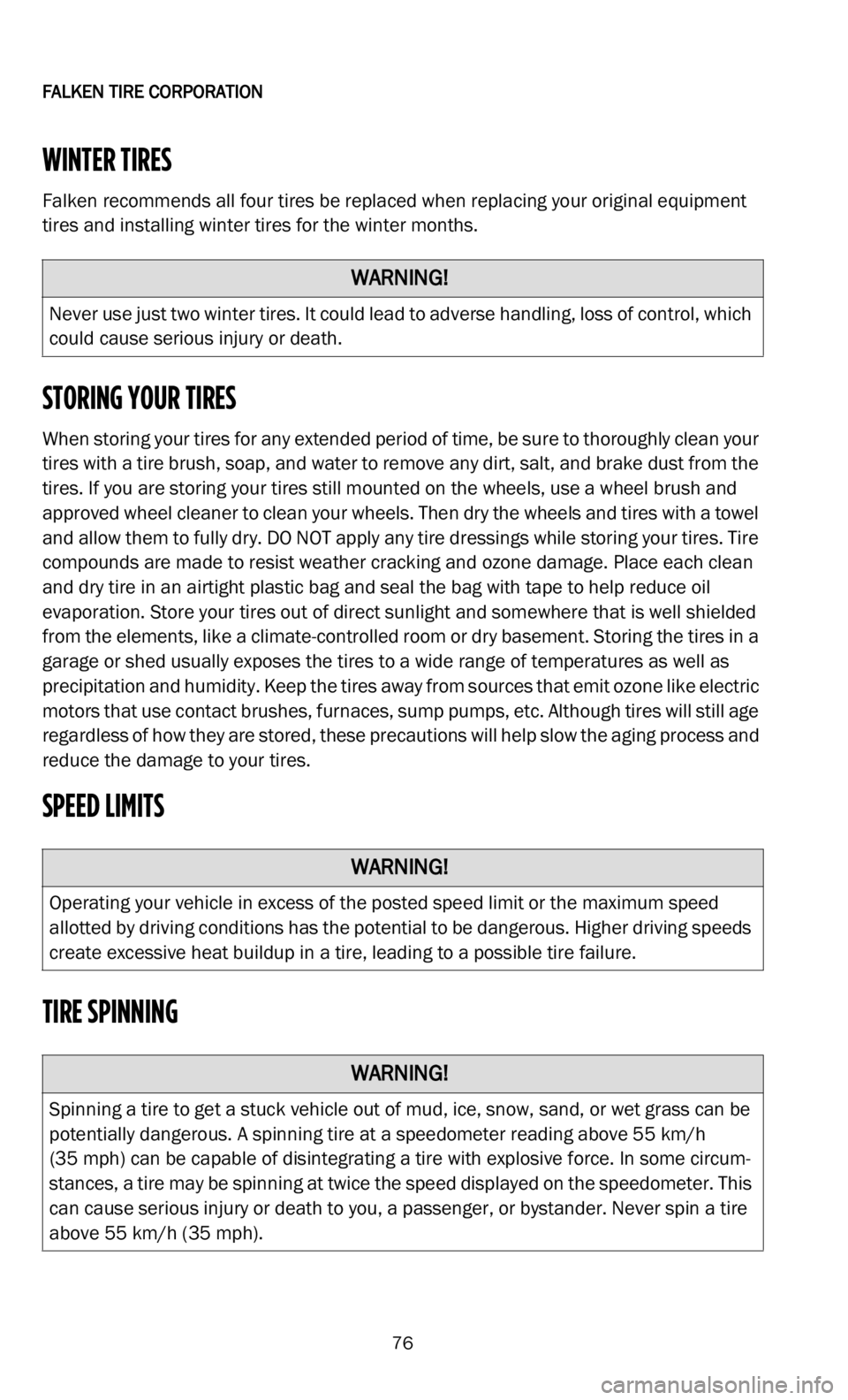air condition DODGE DURANGO 2022 Vehicle Warranty
[x] Cancel search | Manufacturer: DODGE, Model Year: 2022, Model line: DURANGO, Model: DODGE DURANGO 2022Pages: 200, PDF Size: 6.72 MB
Page 63 of 200

BRIDGESTONE® - FIRESTONE®
62
sion components, improper tire mounting or demounting, tire/wheel assembly
imbalance, or other vehicle conditions, defects, or characteristics.
• Contamination or degradation
by petroleum products or other chemicals, fire or
other externally generated heat, or water or other material trapped inside the tire
during mounting or inflation.
• Improper repair.
Improper repair voids this Limited Warranty
• For RFT tires only, improper run-flat or low tire pressure operation,
including,
without limitation: Exceeding speed, distance, or other run-flat/lowpressure oper-
ation limitations.
2. R apid tread wear or wear-out. Original equipment tires have no mileage warranty.
3
. W eather/ozone cracking after 4 years from date of tire manufacture.
4
. R ide disturbance or vibration after 1/32 of an inch (0.8mm) of tread wear use.
5
. T ires with sealant, balance, or other filler material that was not originally applied or
i
nserted by the tire manufacturer.
6. T ires used in commercial service.
7
. T ires purchased and normally used outside the United States and Canada.
8
. T he cost of applicable federal, state, and local taxes.
9
. F ailure to follow any of the safety and maintenance recommendations or warnings
c
ontained in this manual.
This Limited Warranty is in addition to and/or may be limited by any other applicable
w r
itten warranty you may have received concerning special tires or situations.
REPLACEMENT PRICE
Radial passenger and light truck tires adjusted under this Limited Warranty will be
replaced free of charge during the first 25% of tread wear or within 12 months from the
d a
te of purchase (proof of purchase date required; without proof of purchase date, then
within 12 months from the date of tire manufacture), whichever occurs first. During the
f r
ee replacement period, mounting and balancing are included free of charge.
To determine the replacement price after the free tire replacement period, the percent
o f
used tread wear is multiplied by the current selling price for the replacement tire(s).
The appropriate taxes, mounting, balancing, disposal fee, and other service charges may
be added to the adjustment replacement price.
In Canada, the tire will be adjusted at dealerships (subject to dealer discretion) at a
p r
edetermined “Adjustment Price.”
REPLACEMENT WARRANTY
If you receive a replacement tire under this Limited Warranty, it will be covered by the
manufacturer’s warranty, if any, given on that tire at that time.
Page 70 of 200

CONTINENTAL TIRE
69
regardless of mileage or months of service. This includes payment for tire rotation,
alignment, towing, road service, valve stems and tire repairs.
Owner is responsible for maintaining proper tire air pressure and for proper maintenance
o f
the tire.
SAFETY WARNING:
Ignoring any of the safety and information contained in this warranty may result in tire
f a
ilure, causing serious injury or death.
• Tire failure due to underinflation/overloading.
Follow vehicle Owner’s Manual or tire
placard in vehicle for proper inflation and loading.
• Explosion of tire/rim assembly due to improper tire mounting.
Tire mounting/
demounting can be dangerous. It should be performed only by a trained tire specialist
using proper tools and procedures. Prior to tire mounting/demounting, the US Tire
Manufacturers Association (USTMA) wall charts and manuals should be read to obtain
the proper procedures. The failure to follow these procedures may result in faulty posi -
tioning of the tire and/or rim, which may cause the assembly to burst with force suffi -
cient to cause injury or death.
• T
ire failure due to damage.
Inspect your tires frequently for scrapes, bulges, separa -
tions, cuts, snags and other damage from road hazards. Damage from impact can
o c
cur to the inner portions of your tire without being visible to the outside. If you
suspect a tire has been damaged from striking anything unusual in the road, you must
have the tire removed from the rim and inspected both inside and out by a trained tire
specialist. Air loss or unusual tire wear can also be warning signs that a tire may have
internal damage. If you notice these conditions, have your tire inspected by a trained
individual.
• T ire failure due to excessive tire spinning. A
void tire spinning. The centrifugal force
generated by a free-spinning tire/rim assembly may cause a sudden tire explosion
resulting in vehicle damage and/or serious injury or death. Never exceed 35 mph
( 5
5km/h) as indicated on your speedometer when your vehicle is stuck in snow, mud,
or sand and your tire(s) is/are spinning. Use a gentle backward and forward rocking
motion to free your vehicle for continued driving. Never stand or permit anyone else to
stand near or behind a tire spinning while attempting to push a vehicle that is stuck.
SELF SUPPORTING RUNFLAT (SSR) TIRE OWNERS
Continental Tire the Americas, LLC (CTA) does not recommend any repair to or reuse of
punctured Continental SSR tires.
Even a trained tire specialist may be unable to recognize internal structural damage to a
S e
lf Supporting Run-flat (SSR) tire resulting from having been driven in an under inflated
or zero inflation pressure condition. Such damage may not be visible on the surface of
the inner liner or sidewall making it impossible to determine the tire suitability for repair
or reuse. CTA does not recommend any repair to or reuse of Continental SSR tires. You
may visit https://www.continentaltire.com/ or www.continentaltire.ca and select
Customer Care FAQs to obtain additional SSR information.
Page 71 of 200

CONTINENTAL TIRE
70
TEMPORARY SPARE TIRE OWNERS
CTA does not recommend any repair to or reuse of punctured Temporary Spare Tires.
CONTISEAL™ TIRE OWNERS
A ContiSeal™ tire differs from a non-ContiSeal™ tire in that it has a
sticky, viscous layer from shoulder to shoulder along the inner liner.
T h
is layer is an integral part of the ContiSeal™ tires. It is not designed or intended to act
as a permanent puncture repair (See information below). If an object up to 3/16 of an
inch (5 mm) diameter penetrates the tread of the ContiSeal™ tire, this sticky, viscous
l a
yer is designed to surround and adhere to the puncturing object and prevent air loss
from the tire by providing a near instantaneous seal. If the puncturing object becomes
dislodged from the tire, the material is designed to seal most holes made by objects up
to 3/16 of an inch (5 mm) diameter. While ContiSeal™ tires significanty reduce the
i n
cidence of flats they are not designed to be driven under inflated or in a flat condition.
In all other aspects, ContiSeal™ tires perform exactly like non-ContiSeal™ tires. As with
any tire, regularly inspect ContiSeal™ tires for evidence of cuts, punctures, and loss of
inflation pressure. At a minimum, ContiSeal™ tires should be inspected once or twice a
month and always before a long trip. Punctures or damage not attended to promptly can
result in loss of inflation pressure and/or damage to the tire. ContiSeal™ tires with cuts
and punctures must be inspected by a trained tire specialist as soon as possible. The
trained specialist, must inspect the tire carefully and, according to industry standards, to
determine whether a permanent repair can be made or whether the tire must be
removed from service and scrapped. A permanent repair will require removal of the tire
from the rim and application of a repair method specifically approved for the ContiSeal™
tires.
ContiSeal™ tires are identified by a symbol on the tire sidewall.
CONTISILENT™ TIRE OWNERS
ContiSilent™ tires are designed to reduce noise generated while
driving. A ContiSilent™ tire is lined with a noise reducing foam
i n
sert. It is not designed or intended to act as a puncture repair.
USING ContiSilent™ Tires
In aspects such as mounting, demounting, inflating and balancing, ContiSilent™ tires do
n o
t differ from non-ContiSilent™ tires. As with any tire, regularly inspect ContiSilent™
tires for evidence of cuts, punctures, and loss of inflation pressure. At a minimum,
ContiSilent™ tires should be inspected once or twice a month and always before a long
trip. Punctures or damage not attended to promptly can result in loss of inflation
pressure and/or damage to the tire. ContiSilent™ tires with cuts and punctures must be
inspected by a trained tire specialist as soon as possible. The trained tire specialist must
inspect the tire carefully and, according to industry standards, determine whether a
permanent repair can be made or whether the tire must be removed from service and
scrapped.
Page 74 of 200

FALKEN TIRE CORPORATION
73
Example of what your tire placard looks like:
CHECKING YOUR TIRE AIR PRESSURE
Checking your air pressure at least once a month is vital to help your tires perform
p r
operly and help you get the best gas mileage possible. Tires can lose up to 7 kPa
(1 psi) per month under normal conditions and lose up to 7 kPa (1 psi) per every 9°C
( 1
6°F) drop in temperature. Here are some simple steps on how to check the air
pressures in your tires:
1. R emove the valve stem cap.
2
. P lace the end of the tire gauge firmly against the tire’s valve stem.
3
. R ead the current pressure displayed on the gauge that is currently in the tire.
4
. I ncrease pressure at this time (if needed) and recheck with your tire gauge.
5
. R eplace the valve stem cap.
6
. R epeat until all of your tires have been checked and adjusted accordingly.
TIRE PRESSURE MONITORING SYSTEM (TPMS)
A Tire Pressure Monitoring System (TPMS) is a safety system found in most
vehicles manufactured after 2005. There are pressure sensing transmitters
mo
unted inside of each tire that send readings to the central computer in your
vehicle. The TPMS system will alert you when one or more of your tires are
underinflated by 25% or more by turning on a warning light on your vehicle’s
dashboard or Heads Up Display (HUD) screen. This means that one or more of your tires
may have a low-pressure condition. Follow the instructions in your Owner’s Manual.
ROTATION AND WEAR
Falken recommends rotating your tires at least every 8,000 km (5,000 miles).
Pe
riodically inspecting your tires to make sure they are free of road hazards (such as
nails, screws, large wood splinters, etc.) that might penetrate your tires causing them to
lose air pressure and to ensure they are wearing evenly. Common irregular wear patterns
are: misalignment wear, where the tire shows excessive outer or inner tread wear. Tire
sidewalls should also be inspected for cuts, snags, bruises, and weather cracking. If any
Page 75 of 200

FALKEN TIRE CORPORATION 74
of these noted conditions are present during inspection, we recommend returning to
your servicing tire dealer to be corrected to ensure long tire life. ***Never include a
temporary spare tire in your rotation pattern***
TIRE REPLACEMENT
Falken recommends replacing your tires when the tread wears down to the wear bars at
1.6 mm (2/32 of an inch), which are located across the tread in several locations around
t h
e tire. If only two tires are being replaced, the two new tires should always be installed
on the rear of the vehicle to aid in preventing your vehicle from hydroplaning, even if your
car is front wheel drive. It is always recommended to have your new tires balanced during
installation, and alignment checked if the previous tires show and irregular wear. Tires
that have been in use for five years or more should continue to be inspected by a
qualified tire specialist, at least annually. It is recommended that any tires 10 years old
or older from the date of manufacture, including spare tires, be replaced with new tires
as a precaution even if such tires appear serviceable and even if they have not reached
the legal worn out limit at 1.6 mm (2/32 of an inch).
TIRE REPAIRS
In the event that you get a flat tire while driving, it is best to find a nearby, safe place to
stop and install your spare tire or call a tow truck. The less distance that you drive on your
low or flat tire, the better chances your tire has of being repairable. Once you are able to
get to your local servicing tire dealer, have them dismount the tire from the rim and
thoroughly inspect the inside of the tire. It is important to know the difference between a
proper tire repair and an improper one because it can be critical to you and your vehicle’s
safety. An improper repair could pose a safety threat to you and your family and could
also affect your tire’s manufacturer warranty. Here are some tips in determining if your
damaged tire can be properly repaired or not:
• Always have the tire removed from the wheel and inspected before any repair is
p
erformed.
• T ires with less than 1.6
mm (2/32 of an inch) of tread should NOT be repaired.
• N ever repair a tire with a puncture larger than 6
mm (1/4 of an inch).
• R epairs should be limited to the tread area only.
•
Repairs cannot overlap one another.
Page 76 of 200

FALKEN TIRE CORPORATION
75
• A plug and patch or plug/patch combo should be used to effectively repair a tire punc -
ture.
• I f anything seems questionable at any time during the repair process, ask your service
a
dvisor for more details and/or call the tire manufacturer to make sure the tire’s
warranty is not being voided.
TIRE MIX USAGE
TIRE SPEED RATINGS
Falken recommends replacing your tire(s) with the same speed rating as the original tires
equipped on your vehicle.
It is okay to use a lower speed rated tire when using Winter tires. However, speeds should
b e
reduced to match the tires new “maximum” speed capability.
Any tire that is repaired, damaged, abused, altered from its original state or retreaded
v o
ids the speed rating on that particular tire and should be considered a non-speed rated
tire.
HIGH PERFORMANCE, LOW ASPECT RATIO TIRES
Various new vehicles come equipped with high performance and/or low aspect ratio tires
from the factory. These tires generally provide increased vehicle handling
characteristics, but may also have engineering performance trade-offs related with their
designs. Low aspect ratio tires have reduced sidewall heights and may be more
vulnerable to damage from road hazards, potholes, and other objects, like curbs. Your
vehicle’s wheels are susceptible to these same dangers as well. Some vehicles may be
originally equipped with high performance tires that are designed for warmer weather
use, reducing traction in colder, winter weather conditions. High performance tires also
pose the possibility of wearing more quickly, giving a stiffer ride, and producing louder
noise than standard all-season tires during operation. Refer to your vehicle Owner’s
Manual, tire information placard, or qualified tire service professional for more
information about these kinds of tires.
WARNING!
Never mix tires of different size or construction and/or type on any axle. (Except for
temporary use as a spare tire.) Always refer to the vehicle’s owner manual for proper
tire fitments.
WARNING!
Falken does not recommend the use of mixing different speed ratings on a vehicle.
This can cause poor handling and unpredictable steering.
Page 77 of 200

FALKEN TIRE CORPORATION 76
WINTER TIRES
Falken recommends all four tires be replaced when replacing your original equipment
tires and installing winter tires for the winter months.
STORING YOUR TIRES
When storing your tires for any extended period of time, be sure to thoroughly clean your
tires with a tire brush, soap, and water to remove any dirt, salt, and brake dust from the
tires. If you are storing your tires still mounted on the wheels, use a wheel brush and
approved wheel cleaner to clean your wheels. Then dry the wheels and tires with a towel
and allow them to fully dry. DO NOT apply any tire dressings while storing your tires. Tire
compounds are made to resist weather cracking and ozone damage. Place each clean
and dry tire in an airtight plastic bag and seal the bag with tape to help reduce oil
evaporation. Store your tires out of direct sunlight and somewhere that is well shielded
from the elements, like a climate-controlled room or dry basement. Storing the tires in a
garage or shed usually exposes the tires to a wide range of temperatures as well as
precipitation and humidity. Keep the tires away from sources that emit ozone like electric
motors that use contact brushes, furnaces, sump pumps, etc. Although tires will still age
regardless of how they are stored, these precautions will help slow the aging process and
reduce the damage to your tires.
SPEED LIMITS
TIRE SPINNING
WARNING!
Never use just two winter tires. It could lead to adverse handling, loss of control, which
could cause serious injury or death.
WARNING!
Operating your vehicle in excess of the posted speed limit or the maximum speed
allotted by driving conditions has the potential to be dangerous. Higher driving speeds
create excessive heat buildup in a tire, leading to a possible tire failure.
WARNING!
Spinning a tire to get a stuck vehicle out of mud, ice, snow, sand, or wet grass can be
potentially dangerous. A spinning tire at a speedometer reading above 55 km/h
( 3
5 mph) can be capable of disintegrating a tire with explosive force. In some circum -
stances, a tire may be spinning at twice the speed displayed on the speedometer. This
c a
n cause serious injury or death to you, a passenger, or bystander. Never spin a tire
above 55 km/h (35 mph).
Page 79 of 200

FALKEN TIRE CORPORATION 78
Possible non-Covered Reasons/Conditions:
3. OWNER’S OBLIGATIONS
At least monthly, the vehicle owner(s) should check the tires’ air pressure with a
gauge and inflate to the recommended cold air pressure level listed on the driver
door placard. Do not rely on car servicers to perform the checks. The tires should
be rotated at least every 8,000 km (5,000 miles) or earlier if uneven wear is oc -
curring, and proof of maintenance records should be kept. The owner(s) should
h a
ve the tires rebalanced if vibration is experienced, and the vehicle’s alignment
should be checked if uneven or rapid wear is occurring, or when suggested by
the vehicle’s manufacturer.
All warranty claims must be presented to an authorized Falken dealer or partici -
pating car dealership. The owner(s) must present any supporting maintenance
r e
cords and documentation necessary to help determine if the tire(s) in question
are deemed covered by the limited warranty or not.
4. LEGAL RIGHTS
All implied warranties, including warranties of merchantability and fitness for a
particular purpose shall be limited in duration to the above period. To the extent
permitted by law, Falken Tire Corporation shall not be responsible for incidental
or consequential damages, such as loss of use of the tire or the vehicle on which
it is used, inconvenience, or commercial loss, some states do not allow limita -
tions on how long an implied warranty lasts, or the exclusion or limitation of inci -
dental or consequential damages, so the above limitations or exclusions may not
a p
ply to you. This warranty gives you specific legal rights and you may also have
other rights, which vary from state to state. This is the only express warranty ap -
plicable to Falken brand tires and supersedes the terms of any previous warran -
ty. Falken neither assumes nor authorizes anyone to make or assume for it any
o t
her warranty.
Chipping/Chunking/Tearing Puncture
Corrosion/Wreck Racing or any Competition
Fire Repair Failure
Impact Break or Concussions Road Hazards
Improper Inflation Pressure Sidewall Cut or Damage
Improper Mounting/Dismount Theft or Vandalism
Mechanical Defects of the Vehicle Tread Cuts
Misalignment Wheel Imbalance
Misapplication Willful Abuse
Overloading
Page 91 of 200

GENERAL TIRE
90
(“Authorized Dealer”). CTNA will replace the tire pursuant to the terms of this Limited
Warranty and Adjustment Policy. Tires that are replaced under an adjustment basis
under this Limited Warranty and Adjustment Policy become the property of CTNA.
OWNER’S OBLIGATIONS
To make an eligible claim under this Limited Warranty and Adjustment Policy, the owner
must present a claim with the tire to an authorized dealer. For the nearest authorized
dealer, consult the Yellow Pages, the General brand internet address, or the 800 telephone
numbers shown on the back of this Limited Warranty and Adjustment Policy. Owner must
present new vehicle registration form or new vehicle sales invoice indicating the date of
purchase. Owner will be required to sign the CTNA Limited Warranty Claim Form or dealer
replacement sales receipt.
Owner is responsible for paying all applicable taxes set forth under this Limited Warranty
and
Adjustment Policy. Owner is also responsible for paying local tire disposal fees and any
parts or service regardless of mileage or months of service. This includes payment for tire
rotation, alignment, towing, road service, valve stems and tire repairs. Owner is
responsible for maintaining proper tire air pressure and for proper maintenance of the tire.
SAFETY WARNING:
Ignoring any of the safety and information contained in this limited warranty and
Adjustment Policy may result in tire failure, causing serious injury or death.
• Tire failure due to underinflation/overloading.
Follow vehicle Owner’s Manual or tire
placard in vehicle for proper inflation and loading.
• Explosion of tire/rim assembly due to improper tire mounting.
Tire mounting /
demounting can be dangerous. It should be performed only by a trained tire specialist
using proper tools and procedures. Prior to tire mounting/demounting, the Rubber
Manufacturers Association (RMA) wall charts and manuals should be read to obtain
the proper procedures. The failure to follow these procedures may result in faulty posi -
tioning of the tire and/or rim, which may cause the assembly to burst with force suffi -
cient to cause injury or death.
• T
ire failure due to damage.
Inspect your tires frequently for scrapes, bulges, separations,
cuts, snags and other damage from road hazards. Damage from impact can occur to the
inner portions of your tire without being visible to the outside. If you suspect a tire has
been damaged from striking anything unusual in the road, you must have the tire
removed from the rim and inspected both inside and out by a trained tire specialist. Air
loss or unusual tire wear can also be warning signs that a tire may have internal damage.
If you notice these conditions, have your tire inspected by a trained individual.
• Tire failure due to excessive tire spinning.
Avoid tire spinning. The centrifugal force
generated by a free-spinning tire/rim assembly may cause a sudden tire explosion
resulting in vehicle damage and/or serious injury or death. Never exceed 35 mph
( 5
5 km/h) as indicated on your speedometer when your vehicle is stuck in snow, mud,
o r
sand and your tire(s) is/are spinning. Use a gentle backward and forward rocking
motion to free your vehicle for continued driving. Never stand or permit anyone else to
stand near or behind a tire spinning while attempting to push a vehicle that is stuck.
Page 95 of 200

GOODYEAR® DUNLOP® TIRES
94
WHAT IS NOT COVERED BY THIS WARRANTY?
This limited warranty does not cover the following:
• Tires submitted for ride disturbance complaints that are worn beyond the first 2/32 of
a
n inch tread depth or tires submitted for ride disturbance due to damaged wheels or
any vehicle condition.
• G oodyear® does not warrant or give credit in any adjustment transaction for any kind
o
f material added to a tire (e.g., tire fillers, sealants, balancing substances) after the
tire leaves a factory producing Goodyear® or Dunlop® tires, nor will it adjust any tire
that has failed as a result of adding such material.
• I rregular wear or damage due to mechanical condition of the vehicle, improper infla -
t
ion, overloading, high speed spin-up, misapplication, misuse, negligence, racing, use
o f
tire chains, improper mounting or demounting, improper repair, wreck, collision or
fire.
• R oad hazards (includes, but is not limited to, punctures, cuts, snags, impact breaks,
e
tc.).
• A ny tire that, after leaving a factory producing Goodyear® or Dunlop® tires, has been
i
ntentionally altered to change its appearance (e.g., white inlay on a black tire or
regrooved).
• T ires with weather-cracking that were purchased more than four years prior to presen -
t
ation for adjustment or, if purchase date cannot be verified, manufactured more than
f o
ur years prior to presentation for adjustment.
• T emporary spare tires used on vehicles used in racing and on passenger cars in
s
pecial applications such as police pursuit service.
• G oodyear® Unisteel® Commercial Radial Light Truck Tires.
•
Tires removed from service due to improper repairs.
•
Tires supplied as Original Equipment are not eligible for any tread life warranty consid -
e
ration.
• C osmetic weather checking.
•
Tire Pressure Monitoring System (TPMS) – refer to vehicle manufacturer’s warranty.
•
Ultra High-Performance Summer tires are not recommended for Winter use, and tread
o
r shoulder cracking on those tires resulting from Winter use will not be covered under
our warranty.
WHAT ARE YOUR LEGAL RIGHTS?
No Representative or dealer has authority to make any representation, promise or
agreement on behalf of Goodyear®, except as stated herein. Any tire, no matter how well
constructed, may fail in service or otherwise become unserviceable due to conditions
beyond the control of the manufacturer. Under no circumstances is this warranty a
representation that a tire failure cannot occur.
DISCLAIMER: THIS WARRANTY IS IN LIEU OF, AND GOODYEAR® HEREBY DISCLAIMS,
AN
Y AND ALL OTHER WARRANTIES AND REPRESENTATIONS, EXPRESS OR IMPLIED,